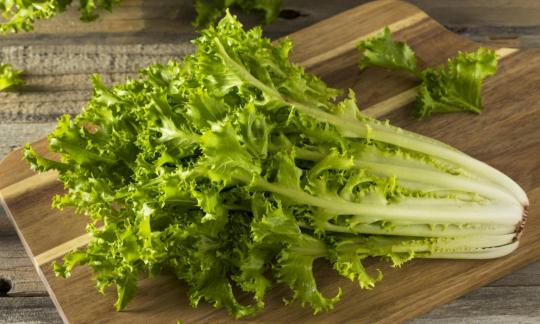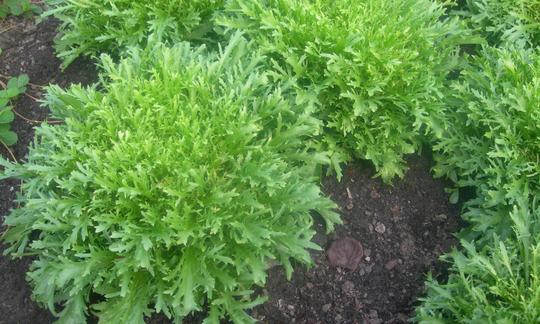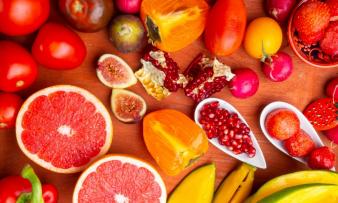Table of contents
Endive ( Cichorium endivia) is a chicory plant that is usually eaten raw (and organic) as a salad. The slightly bitter taste of endive harmonizes with sweet notes.
Use in the kitchen
What are endives? Endive is a salad plant, the best known varieties of which are the smooth endive ( Cichorium endivia var. latifolium), also called escarole, and the curly endive or frisée ( Cichorium endivia var. crispum). Escarole has broad, entire leaves, whereas frisée has narrow, curly leaves. Both varieties form leaf rosettes and are characterized by their hearty, spicy, tart, slightly bitter taste.
Can you eat endive raw? Endive is mostly eaten raw as a salad, e.g. as a starter, as it stimulates the appetite. Fruits such as apples, pears, tangerines, oranges, pomegranate seeds and sweetened dressings (e.g. with agave syrup orraspberries) go well with a raw endive salad as they complement the bitter taste well. Ingredients with earthy notes such as walnuts, hazelnuts, potatoes or lentils can refine the salad. Other types of lettuce (e.g. radicchio, chicory, iceberg lettuce,lettuce) can also be prepared with endive. If endive is still a bit bitter for you despite the addition of sweet components, you should cut off the thick leaf bases which contain the most bitter substances. The endive's bitter substances can also be removed by briefly soaking the cut leaves in lukewarm water. Some people also swear by sugar water. Endive is also used raw as a topping in sandwiches or, for example, to make endive pesto.
Can you prepare endive as a vegetable? Endive can also be eaten boiled. How can you cook endive? Endive vegetables can be steamed, i.e. prepared like chard, savoy cabbage or spinach (e.g. with a little vegan oat cream). Endive is also ideal for soups, stews or purees (e.g. with potatoes). Endive as a vegetable also tastes good in risotto or briefly fried with sweet peppers, for example. Celery, tomatoes, onions and garlic, or spices and herbs such as nutmeg, horseradish, thyme, chives and parsley go particularly well with endive.
As an alternative to endive salad, you could use sugarloaf (meatweed).
Recipe for vegan, fruity endive salad
Ingredients (for 2 people): 1 endive (raw, organic), 2 oranges, ½ bunch of radishes, 1 mango, 1 lime (organic), 30 ml mango juice, 1 tbsp maple syrup, 3 tbsp rapeseed oil, some salt andpepper.
Preparation: For this chicory salad recipe, you first have to wash the endive leaves and shake or spin them dry. Cut off the stalk and cut or pluck the leaves into bite-sized pieces. Peel and fillet the oranges with a knife. Wash the radishes and cut them into thin rings. Peel and dice the mango. Put the endive, oranges, radishes and mango in a bowl. For the dressing, grate the peel of the washed organic lime into a tall container and then squeeze out the juice. Add the mango juice and maple syrup and mix everything well. Add rapeseed oil and season with salt and pepper. Pour the salad dressing over the fruity endive salad (vegan) and serve.
Vegan recipes with endive (raw) can be found under the note: " Recipes that have the most of this ingredient ".
| Not only vegans or vegetarians should read this: Vegans often eat unhealthily. Avoidable nutritional errors. |
Purchasing - Storage
In supermarkets such as Coop, Migros, Denner, Volg, Spar, Lidl, Rewe, Edeka, Aldi, Hofer, Billa, endive is available either whole or as a sliced, packaged salad (often as a mixed salad). Organic supermarkets (e.g. Alnatura, Denn's Biomarkt) offer chicory salad in organic quality. Endive is in season in Switzerland from May to November. Depending on the geographical location, the harvest may not begin until June, but may last until December or January. However, the salad can be found in some supermarkets all year round, where the endive is imported from southern European countries.
The availability of endive varies depending on the size of the store, catchment area, etc. Our recorded food prices for the DA-CH countries can be found above under the ingredient image - and by clicking you can see their development at various suppliers.
Storage tips
Endive is best stored in the vegetable compartment of the refrigerator. Wrapped in a damp cloth, it will keep for three to five days. Raw endive should not be frozen, as the leaves will otherwise have a mushy consistency. Blanched endive, however, can be frozen as needed, like spinach.
Ingredients - Nutritional values - Calories
Endive (raw) contains 17 kcal per 100 g and is therefore very low in calories. Its protein content is low at 1.2 g/100g and fat is also almost non-existent at 0.2 g/100g. The majority of carbohydrates (3.4 g/100g) are fiber (3.1 g/100g). This is significantly more than in other salads such as iceberg lettuce (1.2 g/100g) orlettuce (1.1 g/100g). 1
Does endive contain vitamins? Raw endive is extremely rich in vitamin K with 231 µg/100g (308% of the daily requirement). This content can be compared with that of radicchio (255 µg/100g) and watercress (250 µg/100g). Swiss chard contains even more vitamin K (830 µg/100g). 1
The amount of folate in 100 g of raw endive is around 142 µg, which is 71% of the daily requirement. Kale (141 µg/100g) and romaine lettuce (136 µg/100g) contain a similar amount of folate. Raw chickpeas contain around four times as much folate at 557 µg/100g. 1 However, it should be noted that chickpeas must first be cooked, so the actual content of the heat-sensitive vitamin is lower after preparation.
Manganese is contained at 0.42 mg/100g, which makes up 21% of the daily requirement. This value is comparable to that of chard (0.37 mg/100g) and lamb's lettuce (0.36 mg/100g). Pine nuts have a much higher content of the trace element at 8.8 mg/100g. 1
Note: Most of the endive ingredients, such as minerals and vitamins, are found in the green, outer leaves; the inner, lighter leaves have less of them. 2
The complete ingredients of endive (raw), the coverage of the daily requirement and comparison values with other ingredients can be found in our nutrient tables. In the article Nutrients explained you will get a detailed insight into the topic.
Effects on health
Due to the low calories of endive salad, it helps to combat obesity. In addition to the valuable vitamins and trace elements, endive contains health-promoting bitter substances. These stimulate digestion, have a mild diuretic effect and facilitate the emptying of the gallbladder, which helps with gallbladder problems. 3 The bitter substance lactucopicrin contained in endive is considered, according to an in-vitro study, to be a promising candidate for protection against neurodegenerative diseases. 4 The lactucopicrin found in the milky sap is also said to have an anti-cancer effect on skin cancer cells. 5
Chicory plants (especially chicory, but also endive) contain the dietary fiber inulin. This indigestible polysaccharide has the potential to reduce the risk of diabetes by promoting weight loss and reducing ectopic fat deposits (fat in muscles and liver). 6 Research into the enrichment of foods (functional foods) with inulin shows that the dietary fiber has a positive effect on the intestinal flora, prevents gastrointestinal complications (e.g. constipation) and stimulates the immune system. 7
Endive is a good source of folic acid (folate). A sufficient supply of this vitamin is particularly important during pregnancy. It is necessary for the proper development of the unborn baby's spinal cord. 8
Dangers - Intolerances - Side effects
There are no known significant side effects of endive. However, some Internet sources state that the purines contained in endive, or rather their metabolite uric acid, can lead to gout and digestive problems in susceptible people. The salicylic acid contained in endive can also cause skin rashes in sensitive people. 9
Folk medicine - natural healing
In traditional Chinese medicine ( TCM), endive is said to have a diuretic, digestive and alkalizing effect. It is also said to have a calming effect.
Ecological footprint - animal welfare
Endive is grown outdoors during its main season, where it can tolerate light frost. Compared to cultivation in greenhouses, this is more resource-efficient and has a smaller carbon footprint. Unfortunately, we do not have exact data on endive salad. However, a Swedish climate database shows a value of 0.41 kg CO 2 eq/kg for the related chicory (from the USA). 17 A study from New Zealand on kale, spinach and chicory showed that intercropping achieved significantly better values than monoculture. 21
Vegetables generally have a relatively small carbon footprint and only a fraction of that of animal products, for example. 18 Even if you take the amount consumed into account, endive can be classified as an environmentally friendly vegetable. According to one calculation, endive is in the "green zone", i.e. in the target range of a climate-friendly diet (50% better than the average). 19
We found more detailed information about the water footprint in a study by the University of Florence. Researchers there tried to replace some of the water with sea water to study the effects on the plant ( Cichorium intybus var. silvestre). They also compared the water footprint of different cultivation systems: soilless cultivation (hydroponics) and conventional cultivation in the soil. They tried the salt water experiments on chicory in pots and in hydroponics. They achieved the lowest water footprint with the salt water hydroponic system (30.7 l/kg), followed by conventional hydroponics with 43.5 l/kg, the conventional method in pots and in the field (134.4 l/kg) and in pots with salt water (246.1 l/kg). 16 The global average water footprint of garden lettuce ( Lactuca sativa) is 237 l/kg, that of vegetables in general is 322 l/kg. 15 That of beef is 15,415 l/kg. 14
In organic farming, no synthetic fertilizers or chemical pesticides are used. This leads to lower pollution and ecosystem pollution and, compared to conventionally grown endive, to lower nitrate levels in the lettuce. 2.20
For detailed explanations of various sustainability indicators (such as ecological footprint, CO2 footprint, water footprint), see our article: What does the ecological footprint mean?
Worldwide occurrence - cultivation
Endive probably originates from the eastern Mediterranean. The wild ancestor of Cichorium endivia is not clearly known, but it is suspected that it is closely related to the wild species Cichorium pumilum and Cichorium calvum. 12 Endive was known in ancient Egypt, spread early on to India, and then to Central Europe in the 16th century. Today, endive is cultivated worldwide. 10
Found in the wild
A wild relative of endive ( Cichorium endivia subsp. divaricatum (Schousboe) PD Sell) still grows wild in its area of origin, east of the Mediterranean. 10
Cultivation - Harvest
Endive can be easily grown in your own garden. They like sunny locations with humus-rich, moderately nutrient-rich soil. Depending on the variety, endive is grown in spring or autumn. In early cultivation, sowing takes place in March, planting in April and harvesting from June onwards. In autumn cultivation, sowing takes place between June and July, transplanting between July and August and harvesting from September to November. 11 In organic cultivation, preference is usually given to varieties that are suitable for autumn cultivation and planting takes place in several batches. 2
Endive can be grown in a greenhouse or on a windowsill. To do this, sow the seeds about 1 cm deep in pots and cover them with soil. Germination requires temperatures between 16 and 20 °C. Direct sowing is also possible, but care must be taken to ensure that the endive is not exposed to cold. The end of June to the beginning of July is a good time for direct sowing. Young plants that have been grown in advance can be planted outdoors after three to four weeks. A distance of 30 cm between the plants and a row spacing of 35 cm are recommended. If you plant the plants in April and May, you should cover them with fleece or perforated foil. The young plants should be watered regularly, but avoid waterlogging. As soon as leaf rosettes have formed, water a little less to prevent the leaves from rotting. 11
After about three months, the endives are ready to harvest. The plant does not form proper heads, however; it is more of a rosette, which, depending on the variety, appears head-like or grows loosely. The endive is cut off just above the root with a sharp knife, so that the rosette of leaves stays together and the leaves do not fall apart. If you like, you can bleach the endives two weeks before harvest to reduce the bitter taste. To do this, tie the outer leaves together so that the inner leaves are protected from the sun. Alternatively, you can place a bucket over the plants; this should not affect the endive's development. Make sure that the leaves are dry before bleaching, otherwise they could start to rot. There are new varieties that contain fewer bitter substances or that bleach themselves with tight-fitting bracts. 11
Endive can be grown in cool, temperate zones down to the tropical lowlands - in the tropics it grows better above 500 m above sea level. The average daily optimum temperature for endive is 15-18 °C. Endive can only tolerate light frost and temperatures that are too high cause fibrous leaves. For endive, the soil should be loose and permeable and have a pH value between 6.5-7.8. 10
In addition to the broad-leaved ( Cichorium endivia var. latifolium) and the curly-leaved endive ( Cichorium endivia var. crispum), there is also the cut endive ( Cichorium endivia var. endivia). This variety is rarely cultivated today. It can be harvested several times; the leaves are upright, usually narrow, elongated and can be quite curly. 12
Further information
Endive ( Cichorium endivia) belongs to the daisy family (Asteraceae) and is known as late summer lettuce or sometimes as winter lettuce. Depending on the variety, they are sensitive or insensitive to direct sunlight and some frost.
Possible confusion
Are endive chicory / endive chicory / chicory endive the same thing? Endive ( Cichorium endivia) is closely related to chicory ( Cichorium intybus var. foliosum). They belong to the same genus ( Cichorium), but each form an independent species. 3 The confusion about the two species is further increased by the French name for endive, namely 'chicorée', and chicory is called 'endive' in France.
There is also confusion between endive and radicchio ( Cichorium intybus var. foliosum), as radicchio is sometimes sold under the alternative name 'red endive'. However, these two are also related but different species.
Romaine lettuce ( Lactuca sativa var. longifolia) is sometimes also called 'summer endive'. Although they come from the same family, romaine lettuce belongs to a different genus ( Lactuca).
Alternative names
Endive has many names: generally known as endive salad, antivi or antivi salad. Frisée (frisee), frisée salad, curly-leaved endive or petticoat salad describe the endive with the curly leaves. The endive with the broad leaves is called escarole, escariol, escarole, smooth endive or winter endive. Incorrect spellings such as endive chicory (endive chicory), chicory endive or endive salad chicory occur again and again.
In English, endive is called endive.
Bibliography - 19 Sources (Link to the evidence)
| 1. | USDA United States Department of Agriculture. |
| 2. | Pini U. Das Bio-Food Handbuch. Ullmann Verlag: Potsdam; 2014: 172-3. |
| 3. | Pamplona-Roger JD. Heilkräfte der Nahrung. Advent-Verlag: Zürich. 2006: 171. |
| 4. | Venkatesan R, Shim W-S, Yeo E-J, Kim SY. Lactucopicrin potentiates neuritogenesis and neurotrophic effects by regulating Ca2+/CaMKII/ATF1 signaling pathway. J Ethnopharmacol. 2017;198:174–83. |
| 5. | Zhang X, Lan D, et al. Anticancer action of lactucopicrin in SKMEL-5 human skin cancer cells is mediated via apoptosis induction, G2/M cell cycle arrest and downregulation of m=TOR/PI3K/AKT signalling pathway. J BUON. 2018;23(1):224–8. |
| 6. | Guess ND, Dornhorst A, Oliver N, Bell JD, Thomas EL, Frost GS. A randomized controlled trial: the effect of inulin on weight management and ectopic fat in subjects with prediabetes. Nutr Metab (Lond). 2015;12:36. |
| 7. | Shoaib M, Shehzad A, Omar M, Rakha A, Raza H, Sharif HR, u. a. Inulin: Properties, health benefits and food applications. Carbohydr Polym. 2016;147:444–54. |
| 8. | Likis F. Folic acid. J Midwifery Womens Health. 2016;61(6):797–8. |
| 9. | Medlexi.de Endivie. |
| 10. | Cabi.org Invasive Species Compendium. Cichorium endivia (endives). |
| 11. | Plantura.garden Endiviensalat: Alles zum Pflanzen, Pflegen & Ernten. |
| 12. | Kiers AM. Endive, Chicory, and their wild relatives. A systematic and phylogenetic study of Cichorium (Asteraceae). Gorteria Dutch Botanical Archives - Supplement. 1. Januar 2000;5(1):1–77. |
| 14. | Mekonnen MM, Hoekstra AY. A global assessment of the water footprint of farm animal products. Ecosystems. April 2012;15(3):401–15. |
| 15. | Mekonnen, M.M. and Hoekstra, A.Y. (2010) The green, blue and grey water footprint of crops and derived crop products, Value of Water Research Report Series No. 47, UNESCO-IHE, Delft, the Netherlands. |
| 16. | Atzori G, Guidi Nissim W, Caparrotta S, Santantoni F, Masi E. Seawater and water footprint in different cropping systems: A chicory (Cichorium intybus L.) case study. Agricultural Water Management. Januar 2019;211:172–7. |
| 17. | CarbonCloud. Schweden. |
| 18. | Poore J, Nemecek T. Reducing food’s environmental impacts through producers and consumers. Science. Juni 2018;360(6392):987–92. |
| 19. | Greenpeace Schweiz, Stadt Zürich, Planted Foods AG, Branding Cuisine, Tinkerbelle, Inge, myblueplanet, ProVeg International, Dr. Earth, FightBack und Eaternity. All You Can Eatfor climate - Poster. ayce.earth. 2022. |
| 21. | Pereira B de J, Cecílio Filho AB, La Scala N, Figueiredo EB de. Greenhouse gas emissions and carbon footprint of collard greens, spinach and chicory production systems in Southeast of Brazil. Front Plant Sci. 2. November 2022;13:1015307. |










Comments